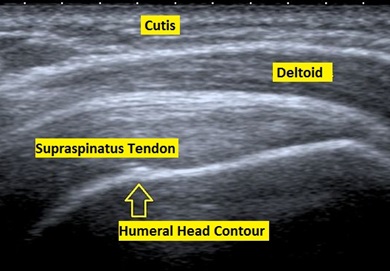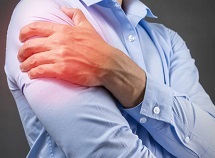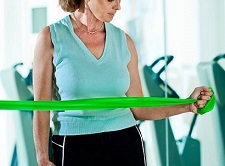- Home
- Shoulder Pain Causes
- Torn Rotator Cuff
Torn Rotator Cuff
Symptoms & Treatment
Written By: Chloe Wilson BSc (Hons) Physiotherapy
Reviewed By: SPE Medical Review Board
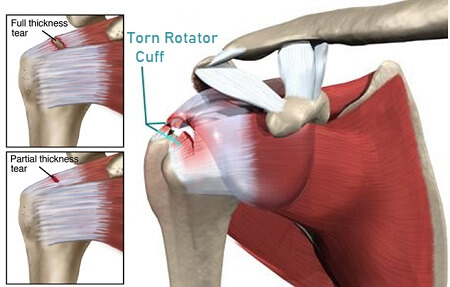
With a torn rotator cuff symptoms include pain across the shoulder, arm weakness and difficulty with activities above or behind your head and back.
The rotator cuff is a group of four muscles which control the movement and position of the shoulder. Damage to the rotator cuff tendons can develop through repetitive wear and tear, or from an injury such as a fall on to an outstretched arm.
Rotator cuff tears are a common cause of shoulder pain and are often associated with shoulder impingement syndrome. They most commonly affect people over the age of forty, sportsmen and construction workers.
Here we will look how the rotator cuff works, how it gets damaged, common torn rotator cuff symptoms, diagnosis and treatment options.
What is the Rotator Cuff?
The rotator cuff is a group of four muscles that work together to control and move the shoulder. The shoulder is made up of three bones:
- Humerus: upper arm bone
- Scapula: shoulder blade
- Clavicle: collar bone
The shoulder joint, aka the glenohumeral joint, is a ball and socket joint. The round head of the humerus forms the ball which sits in the shallow socket formed by part of the scapula.
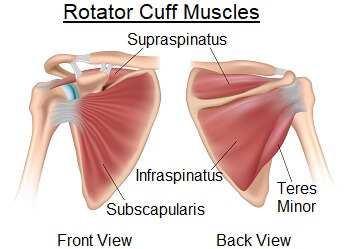
The rotator cuff muscles surround the joint holding the ball and socket together, connecting the humerus to the shoulder blade.
Each rotator cuff muscle arises from the shoulder blade and forms tendons which attach on to the humerus. It is the tendon parts of the rotator cuff that tend to get damaged.
The four muscles that make up the rotator cuff are:
- Supraspinatus: across the top of the shoulder. Initiates abduction i.e. moving the arm out sideways, and stabilises the shoulder during movement. Supraspinatus us the most commonly damaged rotator cuff tendon
- Infraspinatus: at the back of the shoulder. Laterally rotates the arm i.e. turns it outwards
- Teres Minor: at the back of the shoulder below infraspinatus. Laterally rotates the arm i.e. turns it outwards
- Subscapularis: runs across to the front of the shoulder. Medially rotates the arm i.e. turns it inwards
Find Out More: Muscles Of The Shoulder >
What Causes Rotator Cuff Tears?
Torn rotator cuff symptoms can develop:
- Gradually: over time through wear and tear, known as a degenerative rotator cuff tear
- Suddenly: from an injury, known as an acute rotator cuff tear
Degenerative Tears
Degeneration, i.e. wear and tear, is the most common cause of torn rotator cuff symptoms. As we age, the rotator cuff increasingly experiences wear and tear from:
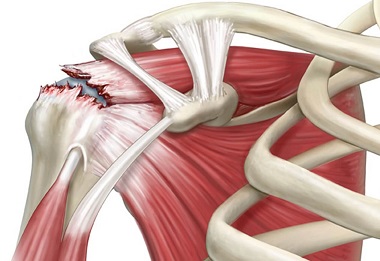
- Repetitive Friction: repetitive activities which involve the rotator cuff, increases the strain on the tendons. Activities where the arm is frequently overhead such as sports with throwing motions or racket sports, occupations involving manual labour and general day-to-day activities above head-height particularly increase the strain on the rotator cuff making it prone to damage.
- Bone Spurs: as we age, we can develop bone spurs, small outgrowths of bone which make our joints less smooth. These spurs can rub on the tendon, leading to fraying and tearing of the tendon.
- Poor Posture: can also make you more prone to a degenerative rotator cuff tear. One example of this is a forward rounded posture, known as kyphosis, as it reduces the space in the shoulder joint, increasing the pressure on the tendons.
- Aging: Over the age of around forty, any damage to the rotator cuff tendons is slower to heal as the blood isn’t as good as when we are young, so often tears never get a chance to heal properly and get progressively worse. As a result, you are much more likely to experience torn rotator cuff symptoms over the age of forty.
Acute Injuries
Torn rotator cuff symptoms can also develop suddenly after an injury. The two most common ways to damage the rotator cuff are:
- A Fall: landing on an outstretched arm
- Lifting: picking up something awkwardly that is too heavy
Younger patients most commonly develop a tear from an acute injury whereas degenerative rotator cuff tears and more common in those over the age of forty.
Torn Rotator Cuff Symptoms
With a degenerative torn rotator cuff symptoms tend to start of fairly mild and get progressively worse over time. Acute rotator cuff tears more typically cause instant, intense pain.
Torn rotator cuff symptoms commonly include:
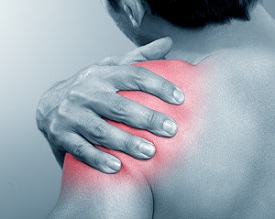
- Pain: across the shoulder, often described as a dull ache deep inside. Rotator cuff tear symptoms tend to get worse when lifting or rotating your arm, with activities such as brushing your hair, or when lying on that side in bed, which often leads to disturbed sleep. As the condition gets worse, you may experience pain even when resting the arm
- Weakness: difficulty lifting or twisting the arm are common torn rotator cuff symptoms, which can lead to decreased range of movement
- Crepitus: you may notice funny shoulder clicking, cracking, grinding or popping noises when you move the arm due to the decreased stability of the shoulder
Torn rotator cuff symptoms will depend on the severity of the injury.
Diagnosing Rotator Cuff Tears
You doctor will start by taking you history, finding out how and when the pain started and how the arm is feeling, to identify torn rotator cuff symptoms.
They will then examine the arm, looking at your range of movement and strength, palpating the different structures and moving your arm into different positions.
They may well also examine your neck, as neck problems often present with shoulder pain.
Depending on your torn rotator cuff symptoms, they may send you for further investigations, such as x-rays, to look for any bone spurs or arthritis or an MRI or ultrasound scan to look at the soft tissues and identify the presence, location and size of a tear.
There are three grades for tendon strains:
- Grade 1 Strain: overstretching of tendon, but no fibers are torn
- Grade 2 Strain: a partial rotator cuff tear – some of the fibers are torn
- Grade 3 Strain: a complete/full thickness rotator cuff tear - the tendon completely detaches from the bone. In this case, you may lose the ability to abduct your arm, i.e. struggle to lift it to the side
Rotator Cuff Tear Treatment
Treatment for rotator cuff tears will depend on the severity of the injury, as well as the age and activity level of the patient. Treatment should target not just your torn rotator cuff symptoms, but the underlying cause of the problem, such as any areas of weakness or postural issues.
In most cases, conservative treatment i.e. non-surgical, is sufficient, but in more severe cases such as grade 3 tears, or if symptoms have failed to settle, surgery may be advised.
Treatment aims to reduce the torn rotator cuff symptoms and usually involves a combination of the following:
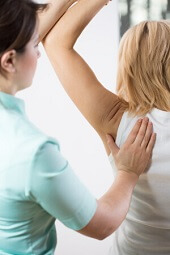
- Rest: It is important to avoid activities that cause pain, else the rotator cuff tear can get worse. With acute tears, you may need to wear a sling initially. However, it is really important to keep the arm moving in a pain-free range, otherwise stiffness and weakness can develop
- Physical Therapy & Exercises: a physical therapist can work on a rehab program with you to help you regain strength and movement in the shoulder as well as address any underlying issues such as poor posture from long term weakness and tightness which may have contributed to the tear in the first place. They may also carry out deep transverse friction massage to help the tendons heal correctly and/or acupuncture to help relieve pain. Visit the rotator cuff exercises section to find out more
- Medication: Your doctor may recommend painkillers and/or anti-inflammatories to reduce your torn rotator cuff tear symptoms of pain and swelling
- Improve Posture: Thinking about how you sit, particularly if you spend long periods in front of a computer can make a big difference to torn rotator cuff symptoms by reducing the pressure and friction on the tendon. Check out our top tips on how to improve posture
- Steroid Injections: your doctor may recommend a steroid injection to help reduce your torn rotator cuff symptoms. A mixture of local anaesthetic and corticosteroid is injected into the shoulder to help reduce pain and inflammation. You can find out more about how steroid injections work on our sister site.
There is no quick fix for torn rotator cuff symptoms and it can take a few months for things to settle down, so it is important to persevere with treatment.
Rotator Cuff Surgery
If torn rotator cuff symptoms have failed to settle with these treatment, or with more severe injuries, then surgery known as a rotator cuff repair may be advised. Rotator cuff surgery is usually considered in the following cases:
- Failure of Conservative Treatment: torn rotator cuff symptoms persist after six months of treatment
- Large Tears: partial rotator cuff tears larger than 3cm or full thickness tears
- Age: rotator cuff surgery is more commonly performed on patients under the age of sixty
- Functional Ability: significant loss of movement and strength in the arm
- Activity Level: someone’s nature of employment or sporting activities require lots of shoulder activity
- Type of Tear: Acute tears are more commonly operated on
They type of rotator cuff surgery carried out will depend on the type and severity of injury. It may be done arthroscopically - keyhole surgery, or through open surgery, where a larger incision is required.
During rotator cuff tear surgery, the torn tendon will be reattached to the bone, any bone spurs will be removed and any other damage will be addressed. You can find out more in the subacromial decompression surgery section.
Following rotator cuff repair surgery, physical therapy is vital to regain the strength and movement in the shoulder - find out more in the rotator cuff exercises section. Recovery from rotator cuff tear surgery usually takes 4-6 weeks.
What Else Can Help?
Torn rotator cuff symptoms are often associated with shoulder impingement syndrome, where the tendon is intermittently trapped by part of the scapula or squashed by an inflamed bursa. You can find out more in the shoulder impingement section.
Torn rotator cuff symptoms are often similar to a number of other shoulder problems so if this doesn't sound quite like your problem, the following articles can help:
- Shoulder Pain Diagnosis
- Common Causes Of Shoulder Pain
- Front Shoulder Pain
- Upper Arm Pain
- Shoulder Pain When Lifting Arm
- Shoulder Pain At Night
- Shoulder Clicking & Popping
Exercises are a really important part of the rehab process to ensure you abolish all torn rotator cuff symptoms and that you regain full strength and mobility in your shoulder - visit the rotator cuff exercises section for a whole range of great exercises that can help.
Related Articles
Page Last Updated: May 21st, 2024
Next Review Due: May 21st, 2026
